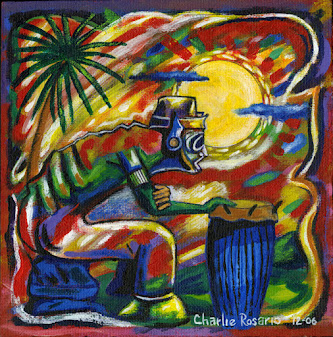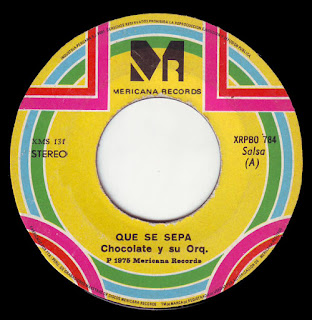The story of a song: Que Se Sepa / Y Que Se Sepa / Mi Quimbín / Síguelo
For quite a few years I have been on the trail of the origins of the Nuyorican salsa anthem “Que Se Sepa” made famous by Roberto Roena y su Apollo Sound in two different versions. The first (1973) was a funky arrangement with breaks and features the distinctive children’s nursery rhyme lyrics, the second (1974) was a more straight salsa version without the playful “la la - bim bim” portion of the first, and containing the “síguelo” lyric and flute instead. I always asked myself why would Roena record two songs with the same title that sound related yet also quite different?

Perhaps due to The Apollo Sound’s success, there were many US-based versions of this tune recorded just after, including Javier Vázquez y su Salsa, Alfredo “Chocolate” Armenteros, and Wuelfo Guitiérrez (all Cubans) as well as Miami’s El Nuevo Conjunto Universal (founded by Cubans). The songs have also been covered by Lito Barrientos (El Salvador), Panchito Nalmy (Peru) (thanks to DJ Freneticos Peru), Johnny Ventura (Dominican Republic) and Orquesta Sabor de Nacho (Puerto Rico). Some go by “Que Se Sepa” or a variant thereof, and others by “Síguelo” or a variant. Are they two different songs, or variations on a theme?
"Y que se sepa" - Los Van Van
Los Van Van (Juan Formell, middle top)
"Mi quimbín" - Los Bocucos
José Couto "Pepito Bocuco"
After careful study I have come to the conclusion that the song actually has its origins in two compositions from Cuba that predate Roberto Roena’s by a year or two. Audio and catalog evidence shows that the first Apollo Sound version is based on “Mi Quimbín” (released on 45 by Los Bocucos, credited to Bocucos vocalist José Couto Pavón “Pepito” and is designated as a “pilón”) and the second is based on “Y Que Se Sepa” by Los Van Van, credited to Juan Formell, listed as a “songo” and released in 1972 on 45 and two various artists compilation, all on the Areíto label. Further research reveals that the Los Van Van predates the Los Bocucos sequentially by catalog number, but since there is no date on the Bocucos 45, it is possible they were both released the same year (1972). Though several US versions credit Cuban ex-pat Titti Soto with the song composition, that seems not to be founded in truth. Who knew? Well, now I can say “Let it be known!”
Spanish:
La historia de una canción: Que Se Sepa / Y Que Se Sepa / Mi Quimbin / Síguelo
Desde hace algunos años he estado en el camino de los orígenes del himno de la salsa nuyoricana "Que Se Sepa", hecho famoso por Roberto Roena y su Apollo Sound en dos versiones diferentes. El primero (1973) fue un arreglo funky con breaks y presenta las letras distintivas de la rima infantil, el segundo (1974) fue una versión de salsa más normal sin la parte lúdica "la la - bim bim" del primero, y que contiene la letra “Síguelo…” en su lugar lírico y flauta también. Siempre me pregunté por qué Roena grabaría dos canciones con el mismo título que suena relacionado, pero también muy distintos.
Tal vez debido al éxito de Apollo Sound, hubo muchas versiones en EEUU de esta melodía grabada justo después, incluyendo por Javier Vázquez y su Salsa, Alfredo "Chocolate" Armenteros y “Wuelfo” Guitiérrez (todos cubanos), así como El Nuevo Conjunto Universal de Miami (fundada por los cubanos). Las canciones también han sido versionados por Lito Barrientos (El Salvador), Panchito Nalmy (Perú) (gracias a DJ Frenéticos Perú), Johnny Ventura (República Dominicana) y Orquesta Sabor de Nacho (Puerto Rico). Algunos van por "Que Se Sepa" o una variante del mismo, y otros por "Síguelo" o una variante. ¿Son dos canciones diferentes, o variaciones en un tema? Después de un estudio cuidadoso, llegué a la conclusión de que la canción tiene sus orígenes en dos composiciones de Cuba que anteceden a Roberto Roena por un año o dos. La evidencia de audio y catálogo muestra que la primera versión de Apollo Sound se basa en "Mi Quimbín" (publicada en 45 por Los Bocucos, acreditada al vocalista de Bocucos José Couto Pavón "Pepito" y se designa como "pilón") y la segunda se basa en “Y Que Se Sepa” de Los Van Van, acreditado a Juan Formell, listado como “songo” y lanzado en 1972 con 45 y dos compilaciones de varios artistas, todo en el sello Areíto. Investigaciones adicionales revelan que Los Van Van son anteriores a los Bocucos secuencialmente por número de catálogo, pero como no hay una fecha en los Bocucos 45, es posible que ambos se lanzaran el mismo año (1972). Aunque varias versiones de los EE. UU. atribuyen a la exilio cubano Titti Soto la composición de la canción, eso no parece estar fundado en la verdad. ¿Quien sabe? Bueno, ahora puedo decir "¡Que se sepa!"

A SELECT DISCOGRAPHY OF QUE SE SEPA
Que Se Sepa /Y Que Se Sepa/Mi Quimbin/Síguelo
Los Van Van – “Y Que Se Sepa” / “Y Me Basta Con Pensar” 45 EPA 6332 Areíto Cuba 1972 (also found on V/A: Grupo De Experimentación Sonora Del ICAIC, Elena Burke, Omara Portuondo, Carlos Puebla Y Los Tradicionales, Orquesta Sinfónica Nacional De Cuba, Los Van Van, Silvio Rodríguez – Seminario latinoamericano de mujeres Estudios EGREM LD-FMC-1 / 2 Cuba 1972; and V/A: Novedades Musicales de Cuba Areíto LDA-3387; also Los Van Van – “Y Que Se Sepa” / “Aquí Se Enciende La Candela” (Juan Formell) 45 Lider – 11701 Peru 1972
Los Bocucos – “Mi Quimbin”/ “Apuntate Una” Areito 45 EPA-6447 Cuba 1972/3?
“Mi Quimbín” (José Couto aka José “Pepe” Couto Pavón “Pepito Bocuco”) Genre: Pilón (Arr: José Couto) Vocals: José Couto, Ibrahim Ferrer
Los Bocucos
Roberto Roena Y Su Apollo Sound – 5 Fania /International Records SLP 00443 US 1973 “Que Se Sepa” (D.R./Titti Soto); also “Cui Cui” / “Que Se Sepa” 45 International 670 1973
El Nuevo Conjunto Universal – Está Pa’ Comerselo…! Velvet LPVA-1466 US 1973 “Que Se Sepa” (D.R./Titti Soto); also “Que Se Sepa” / “No Me Apreites” Velvet 45 2281 US 1973
Orquesta El Sabor De Nacho – Volumen 4 Horoscopo/Borinquen Records SGH-020 Puerto Rico 1973 “Bim Bim Bom Bom ‘Que Se Sepa’” (D.R.); also “Bim Bim Bom Bom ‘Que Se Sepa’” / “Todo Me Gusta De Ti” 45 F-5050 Puerto Rico 1973
Johnny Ventura Y Su Combo Show – La Protesta De Los Feos Mate MATE-02 US 1974 “Mi Se Que Yo” (D.R. arr. J. Ventura); also “Mi Se Que Yo” / “Mi Son Sabe A Mamey” Mate 519 US 1973
Javier Vazquez Y Su Salsa – La Verdad (The Truth) Alegre Records – CLPA 7006 US 1974 “Síguelo” (R.R. arr. J. Vázquez); also “Siguelo” / “Se Formó La Rumbantela” Alegre Records 45 X-4067 US 1974
1976 Japanese pressing with cover illustration and album design by Yosuke Kawamura
Wuelfo - El Sonido De La 4 Inca Records SLP 1034 US 1974
“Síguelo Que Se Sepa” (D.R.); also “Síguelo Que Se Sepa” / “Te Voy A Dar” Inca 45 6073 US 1974
Roberto Roena Y Su Apollo Sound - 6 Fania/International Records SLP 00473 US 1974 “Que Se Sepa” (D.R.); also “Traición” / “Que Se Sepa” 45 80001 US 1974
Chocolate Caliente - Bien Sabroso! Mericana Records XMS-131 US 1975 “Que Se Sepa” (D.R.); also Chocolate Y Su Orquesta – “Que Se Sepa” / “Nicolasa” Mericana Records – XRPBO 784 Peru 1975
Juan Pablo Torres – Con Todos Los Hierros Areito LD-3629 Cuba 1977 “Que Se Sepa” (Juan Formell arr. J.P. Torres); also as Orquesta Cubana Algo Nuevo – Salsita Afro Cubana Phase 6 Super Stereo – VPAS 952 Italy 1977
Tito Allen – Clase Y Sabor MP US 1993; also Discos Fuentes – L.P. 206576, Colombia 1994 “Que Se Sepa” (Titti Soto)
Lito Barrientos Y Su Orquesta – Cumbia Del Caribe Discolito – LDD-17 1974 El Salvador; also Recolite – LDD-17 US 1974 “Que Se Sepa” (D.R.); also Orquesta Lito Barrientos “Metapan” / “Que Se Sepa” 45 Onda Nueva – ON 302 El Salvador
Panchito Nalmy – “Que Se Sepa” / “Mi Amor, Mi Bien, Mi Amada” 45 A-2111 Dinsa Peru “Que Se Sepa” (D.R.)






























































